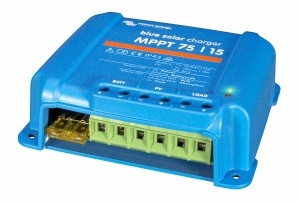Solar Panel Charging: Difference between revisions
No edit summary |
No edit summary |
||
| Line 41: | Line 41: | ||
** Sizes: 6x6-inches, 5x5-inches | ** Sizes: 6x6-inches, 5x5-inches | ||
* Solar Tabbing Wire - connects modules into strings - multiple cells connected together, e.g. 9 cells provides 4.5V (0.5V x 9) | * Solar Tabbing Wire - connects modules into strings - multiple cells connected together, e.g. 9 cells provides 4.5V (0.5V x 9) | ||
* Bus Wire - connects the strings into an panel, e.g. 4 strings provides 18V (4.5V x 4) | * Bus Wire - forms an "S"-shape and connects the strings into an panel, e.g. 4 strings provides 18V (4.5V x 4) | ||
* Flux Pen - makes it easier to solder the tabbing and bus wire | * Flux Pen - makes it easier to solder the tabbing and bus wire | ||
* Encapsulation Film - seals the front and back of the solar cells in a vacuum | * Encapsulation Film - seals the front and back of the solar cells in a vacuum | ||
Revision as of 21:43, 1 June 2016
Basics about solar panel battery charging.
Panels
Monocrystalline panels are regarded as being the most efficient panel technology. Second to Polycrystalline panels.
Common configurations of individual panels:
- 100W - common
- 120W
- 150W - common
- 160W
Arrays are usually build by parallel installation of multiple of the same panel type, e.g. 10x150W panels is a 1500W or 1.5kW array.
Some cheap flexible panels:
- 100W 18V Mono panel - 137USD
Solar controllers
There are two kinds of controllers; MPPT and PWM charging mode, with the former being the preferred one on larger (>50W) setups.
A reasonable decent solar controller starts at 50USD, for a 10 to 30A 12V setup. A 30A controller can handle up to 30 x 12 = 360W of solar panels connected to the input.
- Solar controller 30A 12V - 44USD
Batteries
Using regular 12V or 24V batteries makes it simple to get locally.
Building solar panels
It is possible to build a large solar panel from scratch. You only need to get the individual parts, which is really not that much or hard to put together.
- Solar Cell - photovoltaic module, converts sunlight to electric current, provides approx. 0.5V each
- Sizes: 6x6-inches, 5x5-inches
- Solar Tabbing Wire - connects modules into strings - multiple cells connected together, e.g. 9 cells provides 4.5V (0.5V x 9)
- Bus Wire - forms an "S"-shape and connects the strings into an panel, e.g. 4 strings provides 18V (4.5V x 4)
- Flux Pen - makes it easier to solder the tabbing and bus wire
- Encapsulation Film - seals the front and back of the solar cells in a vacuum
- Backing Sheet - works as an insulator and protects the back of the panel, usually a multilayer laminate
- Mounting Frame - makes it easier to mount the panel to a roof or other installation infrastructure
- Junction Box - connects the two bus ends to screw terminals
- Cable - makes it easier to weatherproof and connect multiple panels together, e.g. in series (higher voltage) or parallel (more current)
- Diode - when panels are installed in parallel and one is damaged, a bypass diode allows the other panels to still work, also blocks reverse current flow

